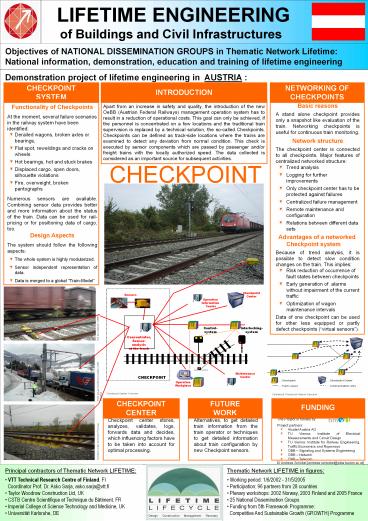Principal contractors of Thematic Network LIFETIME: - PowerPoint PPT Presentation
1 / 1
Title:
Principal contractors of Thematic Network LIFETIME:
Description:
CHECKPOINT SYSTEM NETWORKING OF CHECKPOINTS INTRODUCTION Basic reasons A stand alone checkpoint provides only a snapshot like evaluation of the train. – PowerPoint PPT presentation
Number of Views:39
Avg rating:3.0/5.0
Title: Principal contractors of Thematic Network LIFETIME:
1
CHECKPOINT SYSTEM
NETWORKING OF CHECKPOINTS
INTRODUCTION
- Basic reasons
- A stand alone checkpoint provides only a snapshot
like evaluation of the train. Networking
checkpoints is useful for continuous train
monitoring. - Network structure
- The checkpoint center is connected to all
checkpoints. Major features of centralized
networked structure - Trend analysis
- Logging for further improvements
- Only checkpoint center has to be protected
against failures - Centralized failure management
- Remote maintenance and configuration
- Relations between different data sets
- Advantages of a networked Checkpoint system
- Because of trend analysis, it is possible to
detect slow condition changes on the train. This
implies - Risk reduction of occurrence of fault states
between checkpoints - Early generation of alarms without impairment of
the current traffic - Optimization of wagon maintenance intervals
- Data of one checkpoint can be used for other less
equipped or partly defect checkpoints (virtual
sensors).
Apart from an increase in safety and quality, the
introduction of the new OeBB (Austrian Federal
Railways) management operation system has to
result in a reduction of operational costs. This
goal can only be achieved, if the personnel is
concentrated on a few locations and the
traditional train supervision is replaced by a
technical solution, the so-called Checkpoints.
Checkpoints can be defined as track-side
locations where the trains are examined to detect
any deviation from normal condition. This check
is executed by sensor components which are passed
by passenger and/or freight trains with the
locally authorized speed. The data collected is
considered as an important source for subsequent
activities.
- Functionality of Checkpoints
- At the moment, several failure scenarios in the
railway system have been identified - Derailed wagons, broken axles or bearings,
- Flat spot, reweldings and cracks on wheels
- Hot bearings, hot and stuck brakes
- Displaced cargo, open doors, silhouette
violations - Fire, overweight, broken pantographs
- Numerous sensors are available. Combining sensor
data provides better and more information about
the status of the train. Data can be used for
rail-pricing or for positioning data of cargo,
too. - Design Aspects
- The system should follow the following aspects
- The whole system is highly modularized.
- Sensor independent representation of data.
- Data is merged to a global Train-Model
CHECKPOINT
Checkpoint Center
Sensors
Operation Information Center
Hot box detector (ÖBB)
Control-system
Interlocking-system
Concentrator, Sensor- analysis at the track
Maintenance Center
Train gauge monitoring system (ASE Industry)
CHECKPOINT
Operation Workplace
Checkpoint System Overview
Centralized Checkpoint Network Structure
CHECKPOINT CENTER
FUTURE WORK
FUNDING
Checkpoint center stores, analyzes, validates,
logs, forwards data and decides, which
influencing factors have to be taken into account
for optimal processing.
Alternatives, to get detailed train information
from the train operator or techniques to get
detailed information about train configuration by
new Checkpoint sensors.
- The Project is funded by
- Project partners
- Alcatel Austria AG
- TU Vienna Institute of Electrical Measurements
and Circuit Design - TU Vienna Institute for Railway Engineering,
Traffic Economics and Ropeways - ÖBB Signaling and Systems Engineering
- ÖBB Network
- ÖBB Telecom
Dynamic scale (Schenck Process)
DI Andreas Schöbel andreas.schoebel_at_eiba.tuwien.a
c.at































